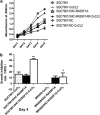Lentivirus-mediated RASSF1A expression suppresses aggressive phenotypes of gastric cancer cells in vitro and in vivo
- PMID: 26005859
- PMCID: PMC4598615
- DOI: 10.1038/gt.2015.49
Lentivirus-mediated RASSF1A expression suppresses aggressive phenotypes of gastric cancer cells in vitro and in vivo
Abstract
Loss of Ras association domain family protein 1 isoform A (RASSF1A) expression is associated with the development of a variety of human cancers and the expression of carcinoembryonic antigen (CEA) frequently occurs in gastric cancer. This study investigated the effects of RASSF1A expression restoration using a hypoxia-inducible CEA promoter-driven vector on xenograft tumor growth in nude mice and on the in-vitro regulation of gastric cancer cell viability, cell cycle distribution, apoptosis, colony formation and invasion capacity. The data showed that the level of CEA mRNA and protein was much higher in gastric cancer SGC7901 cells than in a second gastric cancer cell line, MKN28, or in the MCF-10A normal epithelial breast cell line. RASSF1A expression was restored in SGC7901 cells compared with the negative control virus-infected SGC7910 cells. RASSF1A expression restoration significantly inhibited gastric cancer cell viability, colony formation and invasion capacity, but induced cell cycle arrest and apoptosis in vitro, especially under hypoxic culture conditions. At the gene level, restoration of RASSF1A expression under hypoxic culture conditions significantly suppressed matrix metalloproteinase-2 expression and prevented cyclinD1 expression. A nude mouse xenograft assay showed that the restoration of RASSF1A expression reduced gastric cancer xenograft formation and growth. In conclusion, the restoration of RASSF1A expression using a hypoxia-inducible and CEA promoter-driven vector suppressed aggressive phenotypes of gastric cancer cells in vitro and in vivo. These results suggest that LV-5HRE-CEAp-RASSF1A gene therapy may be a promising novel approach to treat advanced gastric cancer.
Figures







Similar articles
-
Targeted CDX2 expression inhibits aggressive phenotypes of colon cancer cells in vitro and in vivo.Int J Oncol. 2017 Aug;51(2):478-488. doi: 10.3892/ijo.2017.4040. Epub 2017 Jun 13. Int J Oncol. 2017. PMID: 28627695 Free PMC article.
-
CpG island promoter hypermethylation of Ras association domain family 1A gene contributes to gastric carcinogenesis.Mol Med Rep. 2015 Apr;11(4):3039-46. doi: 10.3892/mmr.2014.3055. Epub 2014 Dec 5. Mol Med Rep. 2015. PMID: 25483734
-
Lentiviral vector-mediated survivin shRNA delivery in gastric cancer cell lines significantly inhibits cell proliferation and tumor growth.Oncol Rep. 2015 Aug;34(2):859-67. doi: 10.3892/or.2015.4033. Epub 2015 Jun 5. Oncol Rep. 2015. PMID: 26043753
-
RASSF1A, puppeteer of cellular homeostasis, fights tumorigenesis, and metastasis-an updated review.Cell Death Dis. 2019 Dec 5;10(12):928. doi: 10.1038/s41419-019-2169-x. Cell Death Dis. 2019. PMID: 31804463 Free PMC article. Review.
-
Gene therapy for gastric diseases.Curr Gene Ther. 2008 Jun;8(3):187-200. doi: 10.2174/156652308784746431. Curr Gene Ther. 2008. PMID: 18537593 Review.
Cited by
-
Targeted RASSF1A expression inhibits proliferation of HER2‑positive breast cancer cells in vitro.Exp Ther Med. 2023 Apr 11;25(6):245. doi: 10.3892/etm.2023.11944. eCollection 2023 Jun. Exp Ther Med. 2023. PMID: 37153885 Free PMC article.
-
The tumor suppressive role of RASSF1A in osteosarcoma through the Wnt signaling pathway.Tumour Biol. 2016 Jul;37(7):8869-77. doi: 10.1007/s13277-015-4660-z. Epub 2016 Jan 11. Tumour Biol. 2016. PMID: 26750098
-
CSTB accelerates the progression of hepatocellular carcinoma via the ERK/AKT/mTOR signaling pathway.Heliyon. 2023 Dec 13;10(1):e23506. doi: 10.1016/j.heliyon.2023.e23506. eCollection 2024 Jan 15. Heliyon. 2023. PMID: 38187282 Free PMC article.
-
Suppression of exosomal hsa_circ_0001005 eliminates the Vemurafenib resistance of melanoma.J Cancer Res Clin Oncol. 2023 Aug;149(9):5921-5936. doi: 10.1007/s00432-022-04434-y. Epub 2023 Jan 4. J Cancer Res Clin Oncol. 2023. PMID: 36598578 Free PMC article.
-
Dioscin induces demethylation of DAPK-1 and RASSF-1alpha genes via the antioxidant capacity, resulting in apoptosis of bladder cancer T24 cells.EXCLI J. 2017 Feb 17;16:101-112. doi: 10.17179/excli2016-571. eCollection 2017. EXCLI J. 2017. PMID: 28435431 Free PMC article.
References
-
- 1Jemal A, Bray F, Center MM, Ferlay J, Ward E, Forman D. Global cancer statistics. CA Cancer J Clin 2011; 61: 69–90. - PubMed
-
- 4Gene Therapy Clinical Trials Worldwide, Gene Med. Available at http://www.wiley.com//legacy/wileychi/genmed/clinical (updated January 2014).
-
- 5Rabizadeh S, Xavier RJ, Ishiguro K, Bernabeortiz J, Lopez-Ilasaca M, Khokhlatchev A et al. The scaffold protein CNK1 interacts with the tumor suppressor RASSF1A and augments RASSF1A -induced cell death. J Biol Chem 2004; 279: 29247–29254. - PubMed
Publication types
MeSH terms
Substances
LinkOut - more resources
Full Text Sources
Other Literature Sources
Medical
Research Materials

